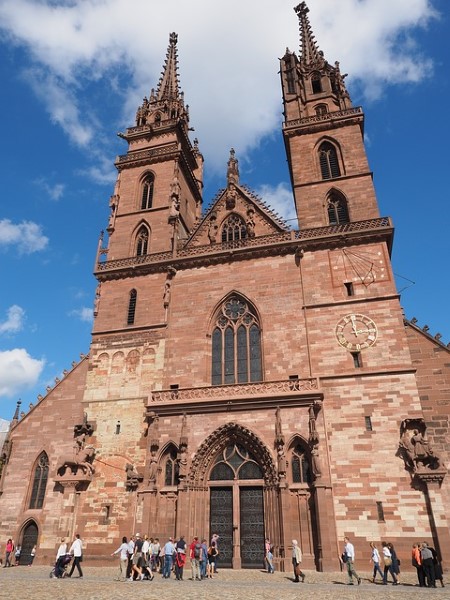1903 Concert Basel 15-06-1903 – Symphony No. 2
The Basel Minster (cathedral) is one of the main landmarks and tourist attractions of the Swiss city of Basel. It adds definition to the cityscape with its red sandstone architecture and coloured roof tiles, its two slim towers and the cross-shaped intersection of the main roof. The Münster is listed as a heritage site of national significance in Switzerland.
Originally a Catholic cathedral and today a Reformed Protestant church, it was built between 1019 and 1500 in Romanesque and Gothic styles. The late Romanesque building was destroyed by the 1356 Basel earthquake and rebuilt by Johannes Gmünd, who was at the same time employed for building the Freiburg Münster.
This building was extended from 1421 by Ulrich von Ensingen, architect of the cathedral towers at Ulm and Strasbourg. The southern tower was completed in 1500 by Hans von Nußdorf.

The red sandstone Münster, one of the foremost late-Romanesque/early Gothic buildings in the Upper Rhine, was badly damaged in the great earthquake of 1356, rebuilt in the 14th and 15th century, extensively reconstructed in the mid-19th century and further restored in the late 20th century. A memorial to Erasmus lies inside the Münster.
Munster. Interior.
Erasmus
Desiderius Erasmus Roterodamus (1466-1536), known as Erasmus or Erasmus of Rotterdam.
When his strength began to fail, he decided to accept an invitation by Queen Mary of Hungary, Regent of the Netherlands, to move from Freiburg to Brabant. However, during preparations for the move in 1536, he suddenly died from an attack of dysentery during a visit to Basel.
He had remained loyal to the papal authorities in Rome, but he did not have the opportunity to receive the last rites of the Catholic Church; and whether he asked for a priest or not is nowhere mentioned in the reports of his death.
According to Jan van Herwaarden, this is consistent with his view that outward signs were not important; what mattered is the believer’s direct relationship with God, which he noted “as the [Catholic] church believes”. However, Herwaarden observes that “he did not dismiss the rites and sacraments out of hand but asserted a dying person could achieve a state of salvation without the priestly rites, provided their faith and spirit were attuned to God.”
He was buried with great ceremony in Basel Minster (the former cathedral).
